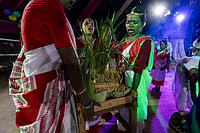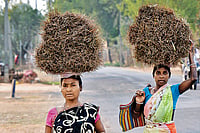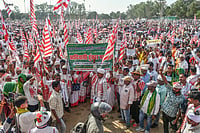This is for the first time 80-year-old Hasina Khatoon experienced such unbearable scorching heat in the summer season of Ranchi. During her 50 years of stay in the city, she has never experienced hot summery winds for such a long duration lasting till 5 in the evening.
“I walk in and around my locality. I used to go for a walk in the evening. However, it has become very difficult to venture out of my house now. The loo (strong, dusty, gusty, hot and dry summer wind) is getting worse. It is only at night that I go to the terrace. Where can I go out in this weather? I fear it will take my life,” she says.
The meteorological department in its previous forecast said that this year the duration of the heat wave would be more than the last year. When the reports came out in early June, the temperature of Ranchi stood at 39.7 degrees Celsius and the heat wave continued till 5 in the evening. During the same period, the temperature of Godda district was 44 degrees Celsius and Daltongunj was 43 degrees Celsius. In view of the soaring heat wave, an orange alert has been issued in Girdih, Deoghar and Godda districts. A yellow alert has been declared for the remaining districts.
Godda, Jamshedpur, Daltongunj and Dhanbad are those districts which have the highest temperatures during summer. However, Ranchi, situated at 650 meters above sea level, has always been known for its cool weather. During the British regime, Ranchi was the summer capital of the erstwhile Bihar (erstwhile Jharkhand was a part of Bihar). However, increasing population and construction of pakka houses brought a drastic change in the weather condition of the city. The formation of Jharkhand (November 15, 2000) further aggravated this change.
Nitish Priyadarshi, Professor of Ranchi University and environmentalist, is of the view that Ranchi has turned from the summer capital to an urban heat island. Had this kind of loo and heat wave ever been in Ranchi? Priyadarshi says, “This kind of heat wave trend was not previously there. There used to be summer heat previously too. However, as soon as the temperature reached 38 to 40 degrees, there used to be rain. Nowadays, even if the temperature goes beyond 40 degrees, there is no rainfall.”
There are, however, a lot of reasons for this scorching heat wave. After the formation of Jharkhand state, the population of Ranchi has almost doubled. Ranchi has a rocky terrain. The city has become a concrete jungle now. Greenery, which was once a part of Ranchi, is no more found here. The heat directly falling on these concrete buildings gets absorbed and radiates back to the atmosphere. As a result, the upper air from upper levels of the atmosphere is pulled toward the ground, where it gets compressed and leads to higher temperatures. Earlier, the flora-fauna, ponds and parks helped in evaporation and brought rainfall to Ranchi, keeping it mostly cool, the scholar explains.
According to the census, the population of Ranchi between 1951 and 2011 soared from 1, 06,849 to 10, 73,427. As per one of the reports, only the municipal corporation area of Ranchi has a population of more than ten lakhs and the entire district has more than thirty lakhs population. According to the census of 2011, the population of the state stands at around 3.29 crores and has been speculated to be around 4 crores at present. There are 15, 25,412 houses in the 24 district headquarters that have been approximated to increase to 21, 96,593.
The weather department believes that it is not only Ranchi or Jharkhand, rather the whole country is reeling under the grip of the scorching heat wave. Last year, till April 28, almost 80 per cent of the country was suffering due to heat wave. This year, the month of March experienced a shocking average of 33.10 degrees Celcius, highest in the last 122 years (33.09 degrees in 1901). With an average temperature of 29.66 degrees Celcius, February 2023 was registered as the hottest in 123 years. (In 1901, the temperature was 29.48 degrees Celcius).
In a span of two years, the temperature of Ranchi has broken all the previous records. As per the Meteorological department, last year the soaring mercury had broken the record of 44 years. The average temperature of the city was 35.8 degrees Celcius between 1969 and 2014 and between 2015 and 2021 it was 36.7 degrees Celcius. In 2022, the average temperature increased to 39.4 degrees Celcius and the maximum temperature notched up to 43 degrees Celcius. Last year in April, Ranchi didn’t experience rain for a single day- for the first time in 23 years. The other districts of Jharkhand also reeled under the maximum temperature of 46 degrees.
Last year, the heat wave continued from the last week of March to April. However, this year the heat wave that began in April-May is lasting to the second week of June. Director of Indian Meteorological Department Ranchi, Abhishek Anand, believes that climate change is playing an important role.
“This heat wave is taking place as a result of climate change. We are not trying our level best to protect ourselves and combat the effects of climate change. Extreme weather is becoming more frequent and more intense. Water, forest and land are no more available. Trees and mountains are disappearing. Population and pollution have increased manifolds. Because of these activities, at the local level, the heat wave is increasing in the city. Climate change has also affected the cycle of weather,” Anand says.
The geographical location of Kolhan and Palamu divisions of Jharkhand is such that these places always experience heat waves. The wave starts from April and continues till May. However, for the last 15 years, the heat wave has been flowing from mid-March. No season has remained normal now.
“Take the month of February this year. It was so hot. Western disturbance has not taken place this time. December, January and February are the main months for the western disturbances. During this period, there is heavy snowfall. Nowadays, no seasonal pattern is followed. Ranchi is a hilly region. Hilly areas have a pleasant climate only till the time the population remains limited. Increase in population will lead to environmental imbalances,” adds Anand.
Anand feels that if land, water and forest problems are not addressed soon, the situation in Jharkhand will aggravate and there will be acute shortage of drinking water in Ranchi. Rising population is affecting the groundwater level. According to media reports, more than 1200 borings have failed in the Municipal Corporation area. Deforestation and increasing population in Jharkhand have also been areas of concern. The latest India state of forest report says that indiscriminate felling down of trees has led to 10108 square kilometre area of land being left without trees.
The change in the nature of forest and land of Jharkhand is now getting reflected in the seasons of the state. A study done by UNDP states that during the summer season in 2050, the average maximum temperature would increase from 41.87 to 43 degrees Celcius. By 2080, this figure would change from 42.09 to 45 degrees Celcius during summer season.
Climate change has affected the normal rainfall in the state. In the last 70 years, there have been changes in the pattern of rainfall. According to the meteorological department, between 1951 and 2000 there has been around 1091.9 mm of rainfall. Between 1961 and 2010, it reduced to 1054.7 mm. and between 1971 and 2020 it became 1022.9 mm.
(Translated by Kaveri Mishra)



























